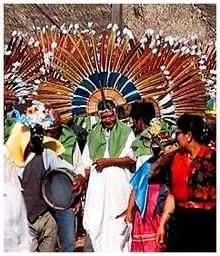- Moxo people
-
The Moxos, also known as the Mojos, are an indigenous people living around the head-waters of the Madeira River in northern Bolivia, particularly on both banks of the Mamore River. They submitted to Inca domination, but in 1564 gallantly repulsed the Spaniards. A century later, however, the Jesuits were welcomed, and the Moxos became Catholic. They numbered some 30,000 in the first decade of the 20th century.
The Moxeno are a tribe of Amerindians that arrived in the Americas approximately 30,000 BCE. They speak a language found in the Arawakan language family and developed early civilizations along the tributaries of the Amazon River found in northeastern Bolivia.[1]
Contents
Moxos Before the Jesuits
The first Jesuits in Moxos encountered a developed, ancient civilization. Thousands and thousands of artificial hills up to 60 feet high dotted the landscape, along with hundreds of artificial rectangular ponds up to three feet deep, all part of a system of cultivation and irrigation. The people used the built-up high ground for farming and dug canals to unite ponds and rivers that caught water in this flood-prone region.
All these architectural and structural masterpieces can be attributed to the ancestors of the present-day Moxeños, who include the Arawak, the most extensive ethnic group in the area. The Moxos language belongs to a language family called Arawakan. The Arawak have always been famous architects, and indeed the great hydraulic works (dated to ca. 250 CE) of their ancient empire is located in the territory of Moxos. Many other ancient nations and language families survive in modern-day ethnic groups, including the Kayuvava, Itionama, and Movima and the Guarayo of the Guaraní family.
Even today one speaks of the "Amazonian cultures" as a block, despite the differences between the various peoples. The Amazonian cosmos includes a tripartite world: the sky above, the earth here, and the underworld below. These cultures believe that the earth is controlled by a father creator, in collaboration with created spirits or dueños, masters, of places or things and with ancestors who help to maintain justice and balance. Slipping from the norm brings about a spiritual sickness that is cured by a communal search for the cause and by a variety of religious rituals, including prayers and natural remedies. In Moxos the principal dueños are the spirits of the jungle (connected with the tiger) and of the water (connected with the rainbow). Many rich dances renew the life of the community and the universe.
The Jesuit missionaries who first encountered the Moxeños found a people with a strong belief in God as father and creator. The Jesuits accepted in their catechism the names the indigenous peoples gave to God in their own languages, trying to embrace all aspects of the culture not contrary to Christian faith or custom.[2]
See also
References
 This article incorporates text from a publication now in the public domain: Chisholm, Hugh, ed (1911). Encyclopædia Britannica (11th ed.). Cambridge University Press.
This article incorporates text from a publication now in the public domain: Chisholm, Hugh, ed (1911). Encyclopædia Britannica (11th ed.). Cambridge University Press.
External links
- Moxos Indians at the New Advent Catholic Encyclopedia.
- Moxenos and the return to San Ignacio.
Categories:- Ethnic groups in Bolivia
- Indigenous peoples of the Amazon
- Indigenous peoples in Bolivia
Wikimedia Foundation. 2010.

